|
F/A-18E Super Hornet

Revell, 1/48 scale
S
u m m a r y
|
| Catalogue Number
and Description: |
85-5519 ‘F/A-18E Super Hornet’ |
| Scale: |
1/48 |
| Price: |
USD$18.46
available online from Squadron.com |
| Contents and Media |
155+ parts on eleven separate
standard grey trees and one clear tree. One water slide decal sheet
featuring one high and one low-viz aircrafts from VF-14 “Tophatters”. |
| Review Type: |
FirstLook |
| Advantages: |
A long anticipated kit. Finely
executed surface and interior details, and comes with a decent selection
of external stores. Very good value for a lot of very decent plastic. |
| Disadvantages: |
Molding quality notably inferior
than other recent Revell offerings. Presence of sink marks and flash are
noted as are slightly soft and inconsistent surface details. Parts break
down may induce fit issues. Fictitious details and awkward short cuts
may need to be addressed. |
| Recommendation: |
Highly Recommended |
Reviewed by
John Chung

Revell's 1/48
scale F/A-18E Super Hornet is available online from Squadron
Reviewer's Disclaimer
It is my humble intend to provide an informative observation of the kit
as-is without sugarcoating or unrestrained bashing. I hope I may provide an
accurate, unbiased insight into the positives and negatives of this kit.
There is plenty of information regarding the development and variants of the
F/A-18 hornet so I will not elaborate further. For more information just google
or yahoo around the net and knock yourself out.
Prior to this release Italeri had the sole 1/48 F/A-18E/F which was known for
numerous inaccuracies and notorious fits. The Revell kit was eagerly anticipated
since its announcement, and when I heard it’s out I promptly ordered one with my
local shop. It’s worth mentioning that Hasegawa will also release its own
tooling of the ‘Rhinos’ later this summer.
This kit has every look and feel of a legacy Monogram kit with recessed panel
lines, a surprise given the high fidelity of recent Revell efforts. This has a
lot to do with it being tooled in China instead of Korea, unlike the F-15E and
F-86D kits. It therefore has slightly softer and inconsistent detailing, and the
surface finish slightly pebbly. Nevertheless adequately fine detailing is
present in the form of recessed panel lines and subtle rivets – lots of them. My
copy has numerous evidences of flash and it’s said the magnitude of this issue
varies by kit. Very little ejector pin marks are will need addressing and
they’ll mostly be hidden once the kit is assembled. Inconsistent molding are
apparent such as the lower fuselage recessed details around the nose gear well
where once side is noticeably shallower than the other.
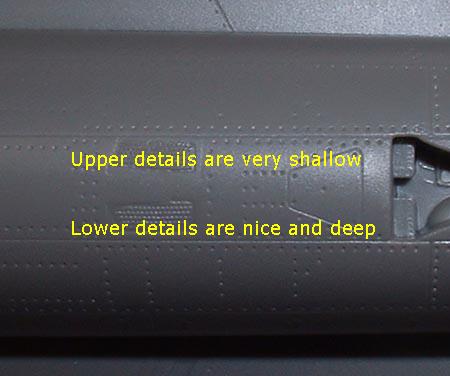
The molded-on Revell Monogram copyright relief on the starboard flap
underneath is a bit cheesy.
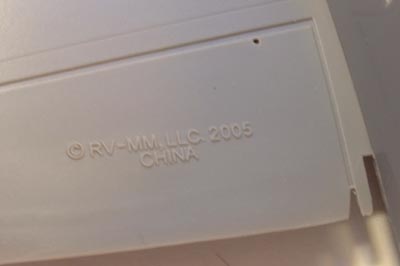
The main fuselage is split horizontally and includes the inboard main wings
molded together, eliminating problematic wing-fuselage joint and alignment
issues. An issue pointed out by Mike Valdez is the forward avionics bay hinges
on the lower fuselage halves which consist of a step in the plastic. This is
understandable as undercuts would have made molding difficult as apparent on the
1/48 Hasegawa hornets. However it is a definite step down from the very
elegantly done hinges on the separate nose halves.
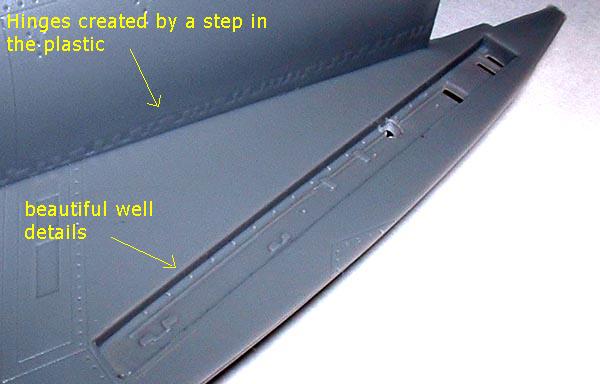
Personally, it’s perfectly legitimate for the exclusion of separate flaps, as
the nature of fowler flap mechanism makes it difficult to replicate in scale
plastic. To this date only the 1/48 Hasegawa and 1/32 Academy kits have ever
attempted this feature. It’s a bit of a disappointment that a typical parked
configuration is impossible OOB, but it’s not difficult to modify the flaps
either. Be aware that the fowler mechanism requires a lot more than just simple
scoring and bending should you attempt the modifications. I have written an
article on this as posted on ARC.
http://www.aircraftresourcecenter.com/tnt1/101-200/tnt114_F-18Flaps_Chung/tnt114.htm
The forward fuselage is split into four pieces with two vertical halves and an
insert each for top and bottom. This allows consistent molding but the fit will
definitely be an issues. There are what initially seem to be sink marks on the
vertical pieces. A quick consultation with the instructions seems they are
intentional but in reality shouldn’t be there and will need filling and
rescribing. A boarding ladder is provided with intricate molding on the ladder
and in the bay, tho the ladder seems to be on the thick side and a tad narrow
looking.
A decent cockpit is provided with simple sidewall and side console relief. It’s
interesting to note the sidewall detail for the aft cockpit is present, evidence
that an F/A-18F may follow in the future. The main instrument panel is
particularly well executed, right down to the individual MFD buttons. The
instrument coaming is sadly nothing short of fictitious, and the cheesy attempt
to duplicate the double glass HUD assembly as one thick lump resulted in a
gaping hole in the middle to prevent sink marks. The aft cockpit decking is
exquisite and will shine once painted and dry-brushed. The control stick and
throttle are separate but their details are okay. The SJU-17 NACES ejection seat
comes complete with very nicely done surface textures and harnesses. However,
the seat does look a tad too boxy, and does not come with any detail on the back
of the seat, which will be partially visible.
The undercarriages are well executed with exquisite and busy-looking main
undercarriage wells, which also have curved roofs and correct depth! The nose
well seems a bit shallow but similarly adequate. A number of gear doors are
molded with sidewall, a little annoying but allows proper detailing of the well
walls. The undercarriages are decent with separate add-ons and molded-on
plumbing. A slight drawback is the main legs being one-piece affairs that don’t
allow knee joint details, but provides the necessary structural integrity. I’m
disappointed at the wheels, which the main are passable and nicely weighted but
the nose rims are too small and generic and the tires too square-looking.
I am particularly impressed by the inclusion of canopy frame details, and the
canopy itself is blown with the properly done cross section which has a mold
line down the centre. The forward windscreen is molded with a section of the
fuselage panel, which I prefer as it reduces the risk of damaging the canopy if
blending into the fuselage is necessary.
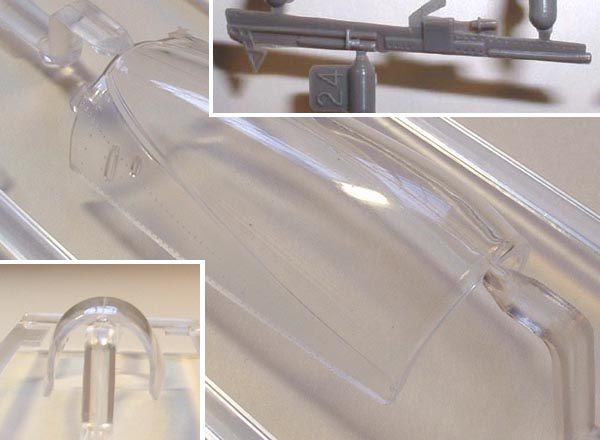
The vertical stabs have plenty but subtly executed rivet details that should
look fine with a couple coats of primer and paint. I must point out that their
leading and trailing edges are too thick and have weird beveling on both the
leading and trailing edges. Coupled with the molded on details it will be
difficult to thin them down and correct this issue.
The horizontal stabs are separate and attach via a moveable connection inside
the main fuselage halves. This particular feature may prevent breakage to the
stabs of they’re hit and to some degree attractive for the kids, it drastically
undersized the “burner cans” by reducing its available reach into the aft
fuselage. In the photo comparison you can see the exhaust is smaller than either
the 1/48 Hasegawa and Monogram Legacy hornets. Similarly, the interior of the
converging-diverging nozzle became too small which may be the reason for the
deep sink mark that trenches the entire nozzle interior. This is an unexpected
fallback as both the Rafale and F-15E have outstanding exhausts.
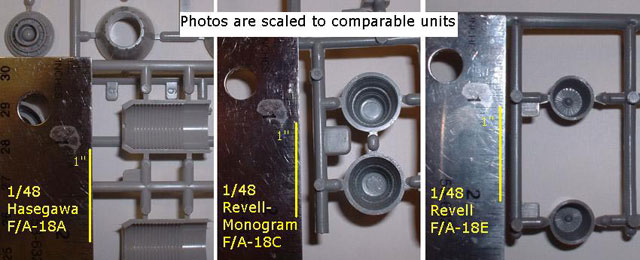
Likewise, the intake is a mixed blessing consisting of a complete trunk and fan
face that goes only about a third its proper length. In reality the trunks end
at the aft bulkhead of the main wheel wells, that’s why the well roofs are
curved being the bottom of the trunks. Revell’s trunks end at just before where
the wells start, which is better than no trunks but still they did provide full
trunks for the F-15E. Ejector pin marks inside the trunks will need cleaning up
as I’m sure the fit of the trunk to intake lips.
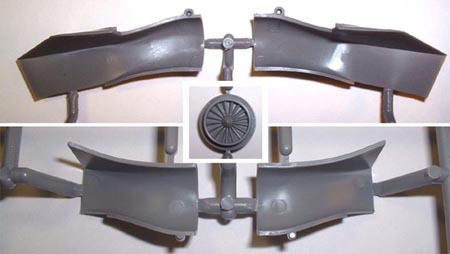
A decent selection of external stores is provided, most of which have never
been tooled in 1/48. Included are 2 x AIM-120C, 2 x AIM-9Xs, 2 x GBU-31-4B JDAM,
2 x Mk.83, 1 x AN/ASQ-228 FLIR pod, and 1 x external tank. The weapons
themselves are nicely done but detail could have been a bit sharper. The
missiles have separate electrical conduits that need to be attached. The bombs
have US Navy fire resistant coatings and separate fins. Would be nice if more
than one external tank is provided tho.
This kit is not perfect and does have its share of issues, none of which are
major and with a bit of basic modeling skills can easily be overcome. There are
also inaccuracies and ‘short cuts’ that could have been done better, leaving the
more “authenticity-zealous” rooms to improve.
That this kit was not tooled in Korea but in China accounts for the slightly
degraded engineering and molding quality. Personally I wouldn’t mind paying
another $5-$10 for a better quality R&D and tooling that would give Tamigawa a
serious run for their money. Nonetheless this kit is extremely well done, of
unbeatable value, and more than worth the delays we have waited. It also gives a
glimpse into the future of the model industry as China continues to rapidly
improve their injection molding technology. Perhaps we’ll soon be able to see
affordable quality products once again, ones that will please the serious
modeler and be affordable to the kid around the block.
Oh, and clear up some shelve space, this is one serious-size airplane!
Highly Recommended.
Sample purchased with reviewer's funds
Click the thumbnails below to view
larger images:
Review Copyright © 2005 by
John Chung
Page Created 18 July, 2005
Last updated 17 July, 2005
Back to HyperScale
Main Page
Back to Reviews
Page
|
Home | What's
New | Features
| Gallery |
Reviews | Reference
| Forum
| Search